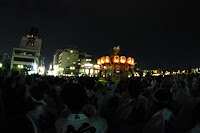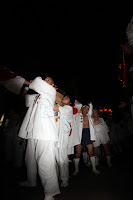
KYOTO GION MATSURI 2013
Il Gion Matsuri (祗園祭), o Festa di Gion, prende il suo nome dal noto quartiere Gion, situato nel distretto di Higashiyama nella città di Kyōto (Giappone). Si tratta di una festa religiosa, nella quale si invoca e si prega il dio Takehaya Susanoo-no-Mikoto, venerato presso il santuario Yasaka.
Insieme allo Jidai Matsuri e allo Aoi Matsuri, il Gion Matsuri costituisce una delle tre più grandi feste religiose di Kyōto.
Si celebra tradizionalmente ogni estate a partire dal 1 luglio per un intero mese allo scopo di calmare gli spiriti dei defunti e invocare la protezione del dio sulla città diKyōto perché tenga lontano malattie e catastrofe naturali. È caratterizzata principalmente dagli eventi Yamaboko Junkō (sfilata dei carri) e Mikoshi Togyo(l’uscita dei palanchini divini), che si svolgono entrambi il 17 luglio, giorno in cui la festa raggiunge il suo apice. fonte: Wikipedia
Insieme allo Jidai Matsuri e allo Aoi Matsuri, il Gion Matsuri costituisce una delle tre più grandi feste religiose di Kyōto.
Si celebra tradizionalmente ogni estate a partire dal 1 luglio per un intero mese allo scopo di calmare gli spiriti dei defunti e invocare la protezione del dio sulla città diKyōto perché tenga lontano malattie e catastrofe naturali. È caratterizzata principalmente dagli eventi Yamaboko Junkō (sfilata dei carri) e Mikoshi Togyo(l’uscita dei palanchini divini), che si svolgono entrambi il 17 luglio, giorno in cui la festa raggiunge il suo apice. fonte: Wikipedia
The Gion Festival (祇園祭 Gion Matsuri) takes place annually in Kyoto and is one of the most famous festivals in Japan. It goes for the entire month of July and is crowned by aparade, the Yamaboko Junkō (山鉾巡行) on July 17. It takes its name from Kyoto's Giondistrict.
During the yoiyama evenings leading up to the parade, some private houses in the old kimonomerchant district open their entryways to the public, exhibiting valuable family heirlooms, in a custom known as the Byōbu Matsuri, or Folding Screen Festival. This is a precious opportunity to visit and observe traditional Japanese residences of Kyoto.Kyoto's downtown area is reserved for pedestrian traffic on the three nights leading up to the massive parade. These nights are known as yoiyama (宵山) on July 16, yoiyoiyama (宵々山) on July 15, and yoiyoiyoiyama (宵々々山) on July 14. The streets are lined with night stalls selling food such as yakitori (barbecued chicken skewers), taiyaki, takoyaki, okonomiyaki, traditional Japanese sweets, and many other culinary delights. Many girls dressed in yukata(summer kimono) walk around the area, carrying with them traditional purses and paper fans. powered by wikipedia.com



























































Nessun commento:
Posta un commento